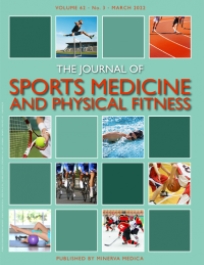La Torre A1, Impellizzeri FM2, Rampinini E2, Casanova F3, Alberti G1, Marcora SM3
1,Institute of Physical Exercise, Health and Sport Activity, Faculty of Exercise Sciences, University of Milan, Milan; 2, Human Performance Lab, Sport Service MAPEI srl, Castellanza, Varese, Italy; 3, School of Sport, Health, and Exercise Sciences University of Wales, Bangor, UK

AIM: Several studies showed that exercise intensity during aerobic step dance can be modified varying stepping rate, bench height and manipulating body mass using hand held or adding loads to the torso. The aim of this study was to determine the cardiovascular responses during aerobic step dance using an overload strategy not yet investigated: appendicular overload. METHODS: Ten healthy and moderately trained women (mean+/-SD: age 27+/-3.4 years, height 167.8+/-4.6 cm, body mass 55.7+/-4.7 kg, body mass index 19.8+/-1.6, VO2max44.4+/-6.1 mLxkg-1xmin-1) performed an incremental treadmill test to determine VO2peak, the VO2-heart rate (HR) and rating of perceived exertion (RPE)-HR relationships. Within 1 week from the laboratory test, the subjects performed two identical aerobic step dance routines: one using a track suit with loads placed in pockets close to the legs and arms and another without overload. RESULTS: The appendicular overload (10% of body mass) significantly increased the exercise intensity from 84.5% to 89.8% of HRmax corresponding to 68.9% and 78.3% of VO2peak, respectively (P<0.01). Similarly, RPE increased from 12.1 to 15.7 (P<0.001). The estimated VO2 and the caloric expenditure rose from 30.3 to 34.7 mLxkg-1xmin-1 and from 251 to 288 kcal, respectively. CONCLUSION: This study shows that the use of appendicular overload significantly increases the energy cost of aerobic step session similarly to other overload strategies already reported in the literature.
J Sports Med Phys Fitness. 2005 Sep;45(3):264-9.
PMID: 16230975